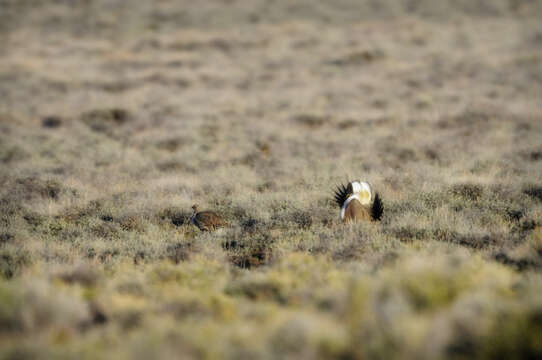Sage Grouse in Lek (14069950484)

Description:
Description: The sagebrush ecosystem is home to unique plant and wildlife species, and is very important to the overall ecological health of eastern Oregon. Many birds and mammals depend on sagebrush ecosystems in the western United States for survival. In the last century, drastic changes caused by livestock grazing, conversion of lands to agriculture, the introduction of exotic plant species, and fire have resulted in alteration and fragmentation of sagebrush vegetative communities throughout the Intermountain West. The loss of sagebrush ecosystems are negatively affecting many of the more than 350 species of plants and animals that depend on sagebrush ecosystems for all or part of their existence including Greater Sage-Grouse as well as Pygmy Rabbit, Mule Deer, and Golden Eagles. Other examples of sagebrush dependent species include sage sparrow, ferruginous hawks, Brewer's sparrow, sage thrasher, sagebrush vole, and many botanical species. Over the last several years, in response to requests from state and local governments to facilitate ways to conserve Greater Sage-Grouse and protect its habitat, BLM scientists and managers met with state wildlife management officials. The BLM strategy emphasizes a cooperative approach and provides a framework to advance efforts to implement timely conservation measures for sage-grouse and its habitat. Additional information about this effort is online at: www.blm.gov/or/energy/opportunity/sagebrush.php. Date: 12 April 2014, 07:02. Source: Sage Grouse in Lek. Author: Bureau of Land Management Oregon and Washington from Portland, America.
Included On The Following Pages:
- Life (creatures)
- Cellular (cellular organisms)
- Eukaryota (eukaryotes)
- Opisthokonta (opisthokonts)
- Metazoa (Animal)
- Bilateria
- Deuterostomia (deuterostomes)
- Chordata (Chordates)
- Vertebrata (vertebrates)
- Gnathostomata (jawed fish)
- Osteichthyes
- Sarcopterygii (Lobe-finned fishes)
- Tetrapoda (terrestrial vertebrates)
- Amniota (amniotes)
- Reptilia (Reptiles)
- Diapsida (diapsid)
- Archosauromorpha (archosauromorph)
- Archosauria (Archosaurs)
- Dinosauria (dinosaurs and birds)
- Saurischia
- Theropoda (theropods)
- Tetanurae (tetanuran theropod)
- Coelurosauria (coelurosaur)
- Maniraptoriformes
- Maniraptora (maniraptoran)
- Aves (birds)
- Ornithurae
- Neornithes
- Neognathae (Neognaths)
- Galloanserae
- Galliformes (landfowl)
- Phasianidae (turkeys, grouse, pheasants, and partridges)
- Centrocercus (Gunnison sage-grouse; greater sage-grouse)
- Centrocercus urophasianus (Greater Sage Grouse)
This image is not featured in any collections.
Source Information
- license
- cc-by-3.0
- copyright
- BLMOregon|sourceurl=https://flickr.com/photos/50169152@N06/14069950484%7Carchive=https://web.archive.org/web/20190113175621/https://www.flickr.com/photos/50169152@N06/14069950484/%7Creviewdate=2018-05-13 18:50:43|reviewlicense=cc-by-2.0|reviewer=FlickreviewR 2
- creator
- BLMOregon|sourceurl=https://flickr.com/photos/50169152@N06/14069950484%7Carchive=https://web.archive.org/web/20190113175621/https://www.flickr.com/photos/50169152@N06/14069950484/%7Creviewdate=2018-05-13 18:50:43|reviewlicense=cc-by-2.0|reviewer=FlickreviewR 2
- source
- Flickr user ID blmoregon
- original
- original media file
- visit source
- partner site
- Wikimedia Commons
- ID


